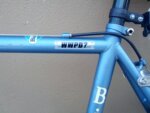Teach me how to fixie
Our Community › Forums › Bikes & Equipment › Teach me how to fixie
- This topic has 134 replies, 27 voices, and was last updated 8 years, 6 months ago by
 Steve O.
Steve O.
-
CreatorTopic
-
October 12, 2016 at 5:10 pm #918680
 JuddParticipant
JuddParticipantSo it’s been six months since I last bought a bike and I’m thinking that I would like to add a fixie to the stable. Since there seems to be a lot of fixed gear expertise I thought I’d ask for some recommendations. I see a few possible routes:
1. Purchase new stock fixie from a LBS.
2. Order a new customizable bike from a place like Pure Fix.
3. Buy a used one on Craigslist
4. Build my ownThe idea of building one appeals to me since it gives an excuse to buy some tools and I like to tinker but I’m interested in others experiences.
Sent from my iPhone using Tapatalk
-
CreatorTopic
-
AuthorReplies
-
October 18, 2016 at 1:05 pm #1059016
dkel
Participant@huskerdont 147459 wrote:
I may get corrected here since I’ve admitted I don’t know what gear inches are and they’re probably more precise, but that’s just the type of quick calculation I’ve used over the years and it’s worked well enough for me. It doesn’t take into account crank arm length etc. like Sheldon Brown’s calculator, but I don’t find I need all that for a quick-and-dirty idea.
Gear inches take into account the size tire you are using. Sheldon’s gain ratio takes into account the crank arm length as well. Any ratio will work to tell you what a gearing will be like, but most FG riders use gear inches to talk about it, so I’d recommend getting comfortable with that measurement, just for the sake of conversation. I made a spreadsheet for myself that would calculate gear inches for a large range of combinations; I just change the tire size in the corner of the sheet, and all the values change. It’s not a hard thing to set up.
For actual riding around these parts, about 70 g.i. Is a good place to start. I’ve gone lower for loaded riding and wider tires, and I’ve gone higher for bare-bones, skinny-tire riding. Some of the local FG monsters go much higher than me, though (closer to 80 g.i.).
October 18, 2016 at 1:11 pm #1059018DismalScientist
Participantgear inches = (wheel diameter)*(chain ring size)/(cog size) or (wheel diameter)*(gear ratio)
So, gear inches is basically 27*(gear ratio) for most adult bikes.
Actual rim and tire size will marginally affect wheel diameter, but 27 is good enough for government work.
Gear inches is the distance the bike will travel with one crank rotation divided by pi.
Crank length doesn’t matter.
As for bottom bracket axle length, I regularly cross chain my fixie, so I don’t care.:rolleyes:
(You’ll probably want a shorter BB axle.)
October 18, 2016 at 1:28 pm #1059019huskerdont
ParticipantThx. For myself, I’ll prolly stick to ratio since that’s what I know, but in discussions like this it’s an easy enough calculation. I see I’ve gone from about 78 to 73. Judd says he’s a masher, and I’d say I was as well, but I’m definitely not one of the beasts I’ve seen around here using huge chainrings and tiny cogs.
October 18, 2016 at 1:43 pm #1059020OneEighth
ParticipantI’ve found 48×16 (81) or 48×17 (76) are pretty good for most of this area, unless you are regularly riding up 41st or Walter Reed, etc.
48×17 will make stopping as well as uphills easier.
In the end, though, whatever works best for you works best for you. Just know that the higher gearing isn’t really all that bad.October 18, 2016 at 1:49 pm #1059021vvill
ParticipantI think with a 40 and your commute, I’d say a 18 is too low really – that’s closer to a CX/gravel SS ratio. I’d go with a 40-16 (as huskerdont suggested), although 17 or 15 would probably be fine too.
FWIW: Dirt, OneEighth and americancyclo ride 48/16. It’s a good road ratio esp. for flatter places like W&OD, Hains Point, etc. if you don’t mind mashing on the Custis and don’t intend to carry cargo, go up 41st St, etc. I’ve used it as a SS ratio for the Tuesday FreshBikes route and it gets a little challenging at times. I ended up settling on a 46T up front and switch between a 16, 17 and 18 fixed cog in the back.
Shorter cranks do make it easier to spin (and reduce the chance of pedal strike) but don’t really factor into gearing for most people. If you happen to ride significantly shorter cranks on a fixed gear, then I’d say you could gear down a little, but otherwise wouldn’t worry about crank length.
October 18, 2016 at 1:54 pm #1059022americancyclo
Participant@vvill 147467 wrote:
FWIW: Dirt, OneEighth and americancyclo ride 48/16.
We are also taller-ish. Except for Pete who is ginormous. but maybe similar height to Judd?
I started riding fixed on a borrowed bike running 45×16 (75 gi)
I bought a fixie a year later with 48×17 (75 gi)
I was spinning a bit too fast for my long legs and 175 cranks.
I just bought a new 16T cog and now run 48×16 (80 gi)
I also upped my tires from 23C to 28C which feels much better.If I were keeping the 40T chain ring, I’d look for a 14T or 15T cog to get you in that 70-75 gi sweet spot.
October 18, 2016 at 2:08 pm #1059024TwoWheelsDC
ParticipantFor puttering around town or riding to class, I found that (46/18) was pretty nice. For my kitted out, relatively high-speed commute with mainly rolling hills, I use 48/16 (also, to be like OneEighth). If you plan on riding the bike in a “spirited” fashion and average above maybe 15mph, I’d say go with 75gi +/- 3gi (2.7-3.0 ratio). My personal preference is to be geared for a lower cadence by default, with room to comfortably increase cadence, rather than spinning like a hamster right off the line (again, this is for more spirited riding).
October 18, 2016 at 2:15 pm #1059025 jrenautParticipant
jrenautParticipantAs you said you’re a masher, which I was when I started riding fixed, I suspect you’ll find 46/18 to be really difficult on any sort of downhill.
October 18, 2016 at 2:24 pm #1059026EasyRider
ParticipantI have a 40T chainring, a 15T fixed cog and a 16T freewheel. I can’t get up Superman Hill with it, but most other hills aren’t a problem. 40×15 limits my top speed because I can’t make my legs a blur.
I converted an old Trek road bike, so I can’t put a larger chainring on there without hitting the chainstay. A bigger ring would need to be mounted further out, and I think I’d need to replace my BB with a longer spindle or redish the rear wheel to maintain chainline.
Others will correct me if I’m wrong, but purpose built track/fixed gear bikes have narrower chainstays and 120mm rear dropouts, which makes fitting larger chainrings easy. I think Dirt, americancyclo and Pete all ride such frames, yes?
October 18, 2016 at 2:40 pm #1059027dkel
Participant120 rear spacing is common on FG bikes. My last FG build used 135 rear spacing, though, and fixed hubs can be had in that spacing (as well as others). My 135 hub was threaded for a fixed cog on one side, and I used a 6-bolt fixed cog to attach to the disc mount on the other side; chain line was the same for both, resulting in a fixed/fixed setup. That took fat tires, too. 😎
October 18, 2016 at 2:46 pm #1059028 JuddParticipant
JuddParticipant@americancyclo 147468 wrote:
We are also taller-ish. Except for Pete who is ginormous. but maybe similar height to Judd?
.I’m 6’3″ which I think is on the ginormous side.
Sent from my iPhone using Tapatalk
October 18, 2016 at 2:50 pm #1059029Tim Kelley
ParticipantOctober 18, 2016 at 3:14 pm #1059032americancyclo
Participant@Judd 147474 wrote:
I’m 6’3″ which I think is on the ginormous side.
Sent from my iPhone using Tapatalk
You are on the taller-ish side. at least as far as this forum is concerned.
October 18, 2016 at 3:30 pm #1059034EasyRider
Participant@dkel 147473 wrote:
120 rear spacing is common on FG bikes. My last FG build used 135 rear spacing, though, and fixed hubs can be had in that spacing (as well as others). My 135 hub was threaded for a fixed cog on one side, and I used a 6-bolt fixed cog to attach to the disc mount on the other side; chain line was the same for both, resulting in a fixed/fixed setup. That took fat tires, too. 😎
Thanks for the info. My rear wheel was built to fit 120mm dropouts but has spacers on the axles which center it in my frame, which is either 126 or 130. Do you recall what your chainline measurement is with a 135mm rear dropout? Am guessing north of 45mm if it takes fat tires, too?
October 18, 2016 at 3:32 pm #1059035rcannon100
Participant@americancyclo 147478 wrote:
You are on the taller-ish side. at least as far as this forum is concerned.

Actual picture of Tim and Bob observing the puny puny #bikedc community.
-
AuthorReplies
- You must be logged in to reply to this topic.